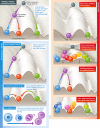Nomenclature for cellular plasticity: are the terms as plastic as the cells themselves?
- PMID: 31475380
- PMCID: PMC6769377
- DOI: 10.15252/embj.2019103148
Nomenclature for cellular plasticity: are the terms as plastic as the cells themselves?
Abstract
It is now recognized that cell identity is more fluid, and tissues more plastic, than previously thought. The plasticity of cells is relevant to diverse fields, most notably developmental and stem cell biology, regenerative medicine, and cancer biology. To date, a comprehensive and uniform nomenclature to define distinct cell states and their injury-induced interconversions has been elusive. The first Keystone Symposium devoted exclusively to cellular plasticity in regeneration and tumorigenesis was held on January 2019 in Keystone, Colorado, and featured a workshop on terminology in the cell plasticity field. Definitions for terms such as plasticity, de- and transdifferentiation, reversion, and paligenosis were discussed. Here, we summarize the content and tenor of the symposium and nomenclature-focused workshop with regard to terms in the field. We outline the challenges with current definitions and recommend best practices and approaches to developing an accurate and acceptable nomenclature in the future.
© 2019 The Authors.
Conflict of interest statement
The authors declare that they have no conflict of interest.
Figures

References
-
- Adami JG (1900) On growth and overgrowth In “Festschrift” in honor of Abraham Jacobi, MD, LLD: To Commemorate the Seventieth Anniversary of His Birth, May Sixth, Huber F, Sondern FE. (eds), pp 422–432. New Rochelle, NY: Knickerbocker Press;
-
- Adami JG, Nicholls AG (1908) The principles of pathology. Philadelphia, PA and New York, NY: Lea & Febiger;
-
- Coggin JH, Anderson NG (1974) Cancer, differentiation and embryonic antigens: some central problems In Advances in cancer research, Klein G, Weinhouse S, Haddow A. (eds), pp 105–165. Cambridge, MA: Academic Press; - PubMed
-
- Graf T, Enver T (2009) Forcing cells to change lineages. Nature 462: 587–594 - PubMed
MeSH terms
Substances
Grants and funding
- DK078803/HHS | NIH | National Institute of Diabetes and Digestive and Kidney Diseases (NIDDK)/International
- DK105129/HHS | NIH | National Institute of Diabetes and Digestive and Kidney Diseases (NIDDK)/International
- R01 DK068471/DK/NIDDK NIH HHS/United States
- R01 DK078803/DK/NIDDK NIH HHS/United States
- DK094989/HHS | NIH | National Institute of Diabetes and Digestive and Kidney Diseases (NIDDK)/International
- P30CA091842/NIH National Cancer Institute/International
- DK110406/HHS | NIH | National Institute of Diabetes and Digestive and Kidney Diseases (NIDDK)/International
- Alvin J. Siteman Cancer Center/Barnes Jewish Hospital Foundation Cancer Frontier Fund/International
- P30 CA091842/CA/NCI NIH HHS/United States
- R01 DK105129/DK/NIDDK NIH HHS/United States
- R01 CA239645/CA/NCI NIH HHS/United States
- R01 DK094989/DK/NIDDK NIH HHS/United States
- R01 DK110406/DK/NIDDK NIH HHS/United States
- DK068471/HHS | NIH | National Institute of Diabetes and Digestive and Kidney Diseases (NIDDK)/International
- R01 DK083355/DK/NIDDK NIH HHS/United States
- R56 DK110406/DK/NIDDK NIH HHS/United States

